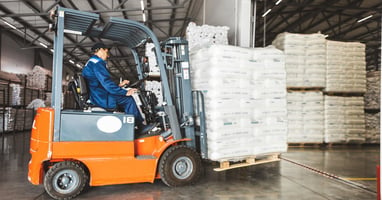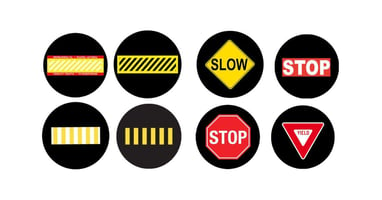Forklifts are essential for lifting and transporting goods of all sizes and weights. They operate...
Why Do Warehouses Need Defined Pedestrian Walkways?

With heavy machinery, a plethora of inventory, and a quick-paced environment, employees are at risk while in warehouses. Safety rules are essential for protecting everyone in the facility.
A valuable feature with an array of benefits are walkways for pedestrians. From operational efficiency to safety, discover the reasons why warehouses need defined pedestrian walkways.
1. Streamlining Operations
Imagine a warehouse where workers constantly dodge machinery. This chaos slows down operations and leads to errors.
Establishing clear paths for foot traffic prevents bottlenecks and confusion. With designated walkways, everyone knows where to go to complete their work safely and efficiently.
2. Reducing the Risk of Injuries
Implementing defined pedestrian walkways directly addresses the concern of workplace injuries. When employees have designated routes, the likelihood of accidents involving forklifts and other machinery decreases. This spatial organization allows forklift operators to maintain better visibility and reduce the chances of unforeseen encounters.
Additionally, the presence of walkways encourages safe practices among workers. They’ll adjust to following these pathways and adopt a culture that prioritizes safety.

3. Providing Easy Navigation
Warehouses are large and complex. Pedestrian walkways make navigation easier by guiding workers to their destinations without confusion.
New employees and visitors benefit greatly from clear walkways, too. They lessen the learning curve and help everyone move efficiently, achieving a smooth and safe workflow.
4. Establishing a More Organized Workspace
In an unorganized warehouse, shouting or signaling becomes necessary to avoid collisions. This noise adds stress and reduces overall productivity.
Keeping areas organized reduces clutter, so employees can locate items quickly. This organizational strategy supports workers in performing their tasks and minimizes the chances of accidents caused by obstructions.
Clearly marked walkways allow workers to identify zones designated for different activities. They can find equipment, products, and safe crossing points to navigate the warehouse with confidence.
5. Complying With Regulations
Regulatory compliance is a non-negotiable aspect of warehouse management. Defined pedestrian walkways help meet safety standards set by organizations such as OSHA.
Specified Regulations for Pedestrian Walkways
Warehouses that fail to comply with safety regulations face severe consequences. Defined walkways are a simple yet effective way to meet these standards. Here are some of the most important components to include in warehouse walkways.
- Clear pathways: Ensure that pedestrian walkways are clearly marked with signage and floor markings to indicate safe routes for foot traffic.
- Safety zones: Designate specific safety zones where pedestrians cannot cross into vehicle pathways without protective barriers.
- Signage requirements: Install adequate signage to warn pedestrians of potential hazards, including approaching vehicles and machinery.
- Lighting standards: Maintain proper lighting throughout walkways to ensure visibility during all hours of operation.
- Speed limits: Implement and enforce speed limits for machinery in pedestrian areas to minimize the risk of accidents.
- Training and awareness: Provide regular safety training for all employees regarding pedestrian safety protocols and the importance of adhering to defined pathways.
6. Establishing Clear Emergency Evacuation Protocols
Emergencies spark panic and confusion. When every second counts, defined pedestrian walkways provide straightforward routes. Every employee can exit the building in an orderly fashion in the face of chaos.
The presence of clear signage, illuminated pathways, and designated exit routes enhances this guidance. This preparation can save lives, reduce the risk of injuries or accidents, and ensure the safety of everyone on the premises.
7. Upholding a Professional Image
Adopting clear walkways is more than just an organizational method; it is a statement of a company’s value system and dedication to creating a secure workplace. Visitors or clients enter a facility with clearly marked paths and perceive it as a top-notch facility.
Moreover, professionalism extends to employee morale and productivity. Workers who operate in a structured environment feel encouraged and motivated to uphold the same standards in their tasks. This culture not only fosters respect among team members but also reinforces a commitment to excellence in daily operations.
8. Enhancing Employee Morale
Clarity in movement contributes to a more positive atmosphere. Workers appreciate knowing their paths and understanding the expectations around safe practices. This openness breeds trust among employees and management.
When workers feel safe, they can focus on their tasks without the constant worry of accidents. They gain a vested interest in maintaining these standards.

Top Precautions To Ensure Pedestrian Visibility in Warehouses
The reasons why warehouses need defined pedestrian walkways are endless. Warehouses should implement strategies that increase pedestrian visibility to forklift operators and other machinery users to improve safety. For example, they can use high-visibility apparel for workers, such as vests and jackets, or create lighted pathways. Here’s a glimpse into some of the best safety components for pedestrian walkways.
Reflective Clothing
Forklift operators will easily spot pedestrians in bright colors and reflective strips. By improving visibility, this type of clothing reduces the risk of accidents.
Impact Barriers
There’s a risk of collisions between vehicles and pedestrians in warehouses without impact barriers. These durable structures safeguard pedestrians from heavy machinery.
Installing impact barriers in high-traffic areas, such as walkways, deflects vehicles away from pedestrian walkways. The physical separation between foot traffic and machinery greatly reduces the likelihood of accidents.
Forklift Safety Light
When walking through a pathway, people often look down. A forward approach to enhance safety is to use a forklift safety light in the warehouse.
The projected LED light falls onto the surface in front of the forklift. As pedestrians go through the walkway, they can keep an eye out for these lights to ensure they’re free from danger. It’s an additional precaution to keep pedestrians secure in walkways.
Virtual Signs
Static signs are easy to overlook. Digital displays communicate important safety information that catches people’s attention. Virtual signs won’t wear down over time, don’t demand frequent replacing, and feature interchangeable signage.
LED Walkways
In the same way that dull signs can go unnoticed, taped or painted walkways are less efficient, too. Warehouses should implement a virtual safety LED walkway instead.
These bright, long-lasting, energy-efficient lights offer clear visual guidance at all hours and for all employees. This illumination helps prevent trips and falls, strengthens communication, and increases safety in the workplace. Your warehouse will become safer than ever before with this addition!
Warehouse safety is Logimate’s priority. We provide high-quality and advanced technology to transform warehouses into safe and efficient environments.
The industry or the style of warehouse doesn’t matter; from large to small facilities, from pharmaceutical to agricultural industries, Logimate has the resources to strengthen operational safety.




